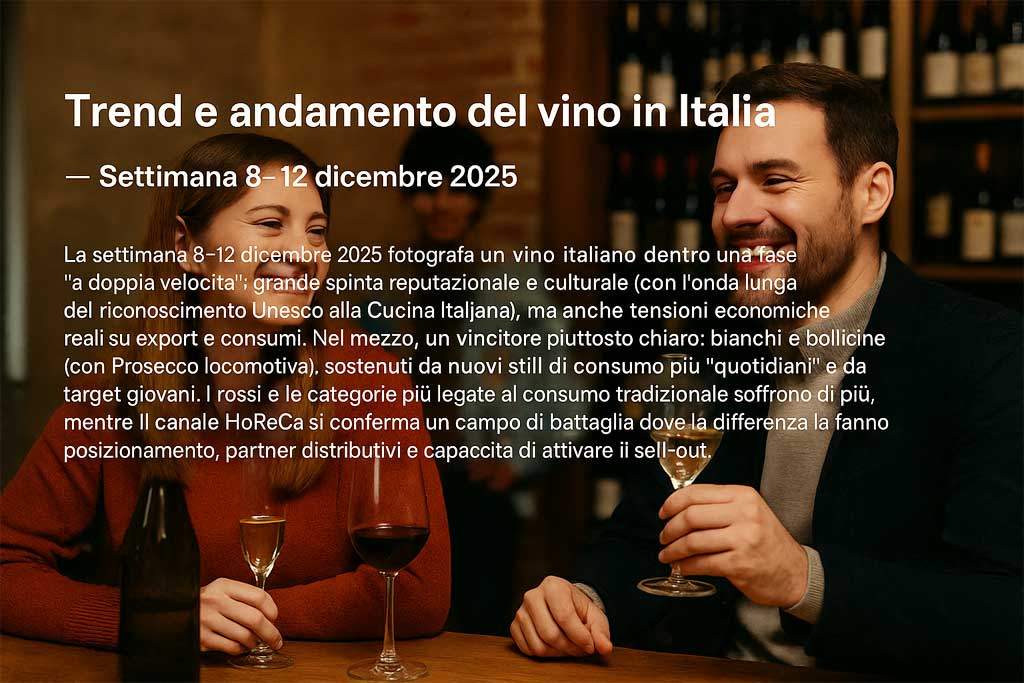The week of December 8–12, 2025, captures an Italian wine in a “two-speed” phase: a major reputational and cultural boost (with the long-lasting impact of UNESCO recognition of Italian Cuisine), but also real economic tensions on exports and consumption.
In the middle, a rather clear winner: whites and sparkling wines (with Prosecco being the driving force), supported by new, more “everyday” consumption styles and a young target audience.
Red wines and categories more closely tied to traditional consumption are suffering the most, while the HoReCa channel remains a battleground where positioning, distribution partners, and the ability to activate sell-out make the difference.
1) UNESCO: Italian Cuisine Recognized, Wine Claims Centrality (and Economic Value)
UNESCO’s recognition of Italian Cuisine as an Intangible Cultural Heritage of Humanity is seen by the industry as a sign of energy to restart in a challenging time. The key message: wine is not an accessory, it is a structural part of Italian dining culture.
- Uiv (Frescobaldi/Castelletti) underlines the impact not only symbolic but also industrial: wine contributes to wealth and employment, with a positive foreign trade balance indicated at around 7.5 billion euros/year .
- Federvini interprets the award as a reward for a comprehensive culture of conviviality, where wines, spirits, and vinegars are pillars of identity; and connects it to new perspectives for promoting Made in Italy products and food and wine tourism .
- Città del Vino (over 500 municipalities) reaffirms the link between production, culture, development, and territorial identity.
- Veronafiere/Vinitaly links the theme to international promotion through its own platforms (Vinitaly and the trade fair “ecosystem”).
- Federdoc emphasizes an additional responsibility: protecting and promoting Designations of Origin as a guarantee of quality, traceability, and sustainability.
- Fivi recalls the concreteness behind the “intangible heritage”: people and territories, especially internal areas , avoiding “embalming” tradition and focusing on economic and social innovation.
- Assoenologi promotes the food-wine union as a historically successful combination, now strengthened by global recognition.
Operational implications: Recognition becomes a powerful narrative and commercial lever, but it only works if translated into action (promotion, wine tourism, DO protection, training, territorial oversight).
2) Consumption: less quantity, more selection. Reward freshness and drinkability.
A clear pattern emerges on the domestic market: people drink less often , domestic purchases are more selective , “special occasions” are on the rise, and categories perceived as more contemporary are prevailing. The focus is shifting toward fresh, versatile, and (partly) lower-alcohol wines , with a growing awareness of well-being and lifestyle.
In this week’s story, this transformation isn’t a collapse: it’s a constant erosion of traditional consumption, with demand redistributed toward segments that are easier to integrate into everyday life.
3) Sparkling wines: structural resilience and a driving force for young people. Prosecco, a global player.
The data and analyses cited confirm that, despite a difficult 2024, sparkling wine is holding up better than still wines in key markets and is strongly appealing to Gen Z and Millennials : bubbles are moving away from the sole logic of “celebration” and entering informal consumption.
Key points emerged:
- Prosecco growing especially in the USA and France , more static in the United Kingdom (signs of a “peak”).
- Champagne in difficulty in three markets: its premium positioning and higher prices make it more vulnerable in a phase of economic uncertainty and “down-trading”.
- Space is opening up for “sidebar” but growing categories: flavoured sparkling wines (USA) , Crémant (France) , English sparkling wines (UK) , and cocktails/spritzes as occasional drivers.
Strategic reading: to grow, simply “making bubbles” isn’t enough; you need to manage consumption moments (aperitifs, informal gatherings, cocktail culture) and speak the language of younger audiences without distorting their identity and quality.
4) US exports: a loud alarm bell (and one to be handled without panic)
Lamberto Frescobaldi (UIV) reports a stark figure: approximately €110 million lost in three months on the US market compared to the same period in the previous year. The picture he describes is one of weakened demand and cautious distribution.
- Italian wine exports to the USA: from 12.5% in value in the first quarter (driven by pre-duty frontloading ) to -4% in the first nine months , with -23% in the last quarter .
- Average price leaving American distribution increased by approximately 4/5 points in October.
- Retail orders for the Thanksgiving period did not pick up as expected.
Operational implications: the key word is “crisis management”: market diversification, work on shelf rotation and perceived value, avoiding both catastrophism and superficial optimism.
5) EU Rules: “Wine Package” between simplification and new categories (No/Low alcohol)
This week saw positive feedback for the EU’s political agreement on the Wine Package , seen as a step towards greater regulatory clarity and business stability. Among the elements highlighted:
- Simplifications on labelling (including push for a harmonised symbol for access via QR code).
- Greater continuity and access to CMO measures.
- Promotion in third countries with extension of programs for up to 9 years (project stability).
- Recognition of wine tourism as a strategic lever.
- Clarifications on the wording for dealcoholized products: “alcohol-free” with “0.0%” below a very low threshold; and “alcohol reduced” for products above certain thresholds and with a significant reduction compared to the starting category (excluding the wording “low alcohol”).
Operational implications: Simplification can free up energy (less bureaucracy, more planning), but the real challenge will be implementation: consistency, timing, and interpretation.
6) HoReCa Italy: market “at breakeven”, but sparkling wines are an exception
In the HoReCa channel, the overall picture is one of slowdown, with the sector projected to close to stability by 2025. Within this scenario, however, sparkling wines stand out as the most dynamic segment.
Data and indications of the week:
- Wine accounts for approximately 17% of beverage distributors’ revenue ; sparkling wines account for 33% of wine sales in the HoReCa sector.
- In the world of sparkling wines, Prosecco accounts for 47% of category sales (almost half the market).
- Signs of difficulty with alcoholic beverages (decreases in wine and beer consumption were reported in some periods), requiring targeted strategies.
Strategic lines suggested by the content:
- Abandon the logic of just sell-in : we need to move the product to the point of consumption ( sell-out , activations, training).
- Choose distribution partners carefully (the market is extremely heterogeneous in terms of size, philosophy, and impact of wine).
- Clear positioning (target and context of use), network support, measurable initiatives and benchmarks.
7) Territories: Collio as a “case study” of white wine endurance
Among the denominations, Collio is described as recovering despite difficulties (taxes and the November flood). Key message: white wines are holding up . Mentioned are:
- Stable sales across key price ranges and markets.
- US exports from Collio are expected to decline by around 10% , a decline deemed absorbable with diversification.
- Northern Europe is positive, Germany is stagnant; China has potential but is inconsistent; Southeast Asia is interesting for its food pairings, but requires promotional work.
Operational implication: Resilience is not “automatic”: it is the result of a market portfolio, consistent positioning, and continuous investment in demand.
8) Outlook 2026: Moderate rebound possible, driven by whites and bubbles
The week ends with a more “breathable” horizon for 2026: stabilizing inflation and the disposal of inventories in some markets open the possibility of a moderate rebound in demand , with white and sparkling wines as the main drivers and more contemporary communication capable of engaging new segments.
At the same time, authoritative voices (such as Carlo Ferrini) urge us to combine realism and confidence: the crisis is multifactorial (overproduction, prices, wars, generational change), but it is also a transformation that can be governed.
Final summary
During the week of December 8–12, 2025, Italian wine is experiencing a typically Italian paradox: at its peak cultural and identity strength (UNESCO) while battling a complex market environment (a slowing US market, more selective consumption). The clearest trajectory, however, emerges clearly: accessible premium, fresh, drinkable, sparkling wines and whites , with more rigorous focus on channels (HoReCa) and markets (export diversification), and with EU regulations that, if properly implemented, can reduce friction and increase the supply chain’s investment capacity.




